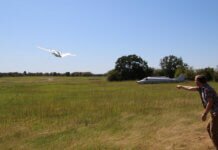 The first half of 2015 has seen a number of Federal Aviation Administration (FAA) announcements regarding commercial unmanned aircraft systems (UAS), including February's proposed rules for small UAS, March's blanket Certificates of Waiver or Authorization (COAs) for Section 333 exemption holders and May's blanket COAs for the FAA test sites. Until the final rules are published, the Virginia test site is taking all necessary steps to help achieve UAS integration into national airspace.
The first half of 2015 has seen a number of Federal Aviation Administration (FAA) announcements regarding commercial unmanned aircraft systems (UAS), including February's proposed rules for small UAS, March's blanket Certificates of Waiver or Authorization (COAs) for Section 333 exemption holders and May's blanket COAs for the FAA test sites. Until the final rules are published, the Virginia test site is taking all necessary steps to help achieve UAS integration into national airspace.
Rose Mooney, who serves as executive director of the Mid-Atlantic Aviation Partnership (MAAP), which runs the Virginia test site, sees the test sites’ blanket COAs – as opposed to individual COAs – as a catalyst for this integration.
By being able to test UAS throughout the country, the test site can “gather the data to support the safety case for the FAA to make true integration happen – and not just the allowances,” she tells Unmanned Aerial Online.
MAAP, located at Virginia Polytechnic Institute and State University, heads the test site – which also includes airspace in New Jersey and Maryland – along with academic partners Rutgers University and the University of Maryland. MAAP’s team also comprises a number of other members, including from industry, government, economic development and universities.
Back when Virginia Tech and its partners were chosen as one of the six FAA-designated UAS test sites, Mooney says, they received a “large swell” of inquiries from interested parties who wanted to come and test UAS. Now that it has been issued the blanket COA, MAAP has seen another boost in interest.
Working with its partners in New Jersey and Maryland, she explains, MAAP can make the site an environment for entities to test their aircraft and also further develop their companies. In turn, more jobs can be brought to all three states, revenue for the local industry can be brought in (e.g., for accommodations and dining), or the companies may want to move there altogether, she adds.
“The important piece of this,” Mooney says, “is helping companies get in the air and get their work done and helping them move toward commercial operations.”
Under the blanket COAs for a Section 333 exemption holder, that entity must apply for an FAA authorization to operate each individual aircraft. However, the test sites’ blanket COAs allow the operation of all types of UAS weighing fewer than 55 lbs.
Mooney explains that although MAAP still conducts a “risk review” for each UAS it flies, the blanket COA speeds things up and hands more power over to the test sites.
“The processes for us are really the same” – in terms of deciding which UAS to fly and assessing the safety of it – “but what it does is expedite the federal side of it,” she says. In turn, she adds, MAAP and its partners can “get it in the air sooner and more cost-effectively.”
And the sooner the UAS can get in the air, the sooner the test sites can conduct research needed to accelerate UAS commercialization.
Back in late 2013, when Virginia Tech was designated by the FAA as one of the test sites, university president Charles W. Steger said in a release that UAS integration “is a great responsibility” but that the team is “ready to meet this challenge.”
Now, roughly a year and a half later, Mooney says that MAAP is doing just that – and has a game plan.
“We see this as a progressive research task,” she says. “What we’re doing today will help inform and improve the commercial UAS situation – and also the safety case.
“Then, we will evolve the test sites to go to the next thing,” which would be allowing them to conduct operations beyond the visual line-of-sight and at altitudes over 200 feet, she says. (Note: The test sites can still operate, through their individual COAs, beyond the blanket COA parameters.)
The test site can then address airspace access for unmanned aircraft. “Right now, airspace classes are limited,” especially under a blanket COA, Mooney explains.
“The test sites are a great place to put industry and government together to actually open a commercial market that’s so important for the U.S. economy and also for aviation,” she says, adding that the safe integration of UAS may, in turn, increase the safety of manned aviation.
Until integration into national airspace happens, she says, “We have been put in place to help inform the FAA of those safety cases and to help those rules and guidelines increase and improve.”









